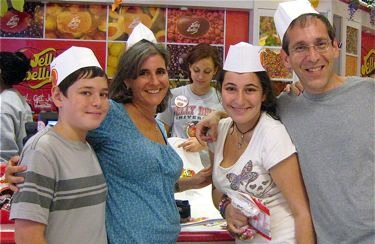El Rancho Navarro is an unlikely name for a Jewish summer camp. It’s not a well-known brand like Ramah, but it’s nevertheless where I spent several formative Julys in the early 1970s. In many ways, I attribute the Zionism I came to embrace later in life to my summers at El Rancho.
I hadn’t been back to my camp, located outside the tiny town of Philo, Calif. in picturesque Mendocino County, for nearly 50 years until a recent visit to the United States when I was invited by Bob Wilms to learn more about The Land, the latest incarnation of the El Rancho property.
Instead of bunk beds in rickety cabins, arts and crafts in the afternoon, and horseback riding on good ‘ol Fred through the lush redwoods, Wilms has transformed El Rancho into a 162-acre rustic meditation, yoga and ecological retreat center.
There are no more horses at The Land; the barn has been turned into a hybrid co-working space and yoga studio with floor-to-ceiling windows overlooking the old paddock.
The main dining hall, where the counselors forced us to take oversized salt pills with our oatmeal for breakfast, looks mostly the same with the addition of an impressive brick fireplace.
The flagpole where we gathered every morning to pledge allegiance is gone, as is the small room where Audrey, the nurse’s daughter who I had a fifth-grade crush on, and I used to play top-40 records while working on the camp newspaper – it’s now a tasteful gym stocked with exercise equipment.
I wasn’t able to enter any of the cabins (they were fully occupied when I visited), but photos on The Land’s website reveal luxurious beds with nary a bunk in sight.
The transformation of bucolic El Rancho to opulent environmentalism was jarring at first to my nostalgic eyes but, as Bob showed me around, I began to see the logic of repurposing a no-longer-used space.
It’s something we see in Israel as well. Indeed, in the spirit of the current season of physical and spiritual renewal, here are a few of my favorite such projects in my hometown of Jerusalem. (This is by no means an exhaustive list and there are similar projects outside of the city. Feel free to add your own repurposings in the comments online or write a letter to the editor.)
Train Track Park. When the train from Tel Aviv to Jerusalem stopped running in 1998 to the former station in the German Colony, the tracks from there to the new station in Malcha were fenced off, becoming an eyesore of trash, weeds and stray cats. The tracks are now a seven-kilometer, wonderfully landscaped park, similar to the High Line in New York City, with a popular parallel bike path. The old station has become the Tahana HaRishona – a shopping, dining and entertainment complex. Take the train to the other end, and you’ll find the original station near Jaffa has been similarly transformed, as have some of the nearby tracks.
The Clal Building. Intended to be Jerusalem’s most state-of-the-art mall when it was built in the early 1970s, the Clal Building instead gained an unsavory reputation with its incomprehensible Escher-like layout, a miserable lack of heating in the winter, and a skylight that collected grime and bird droppings. It’s still an ugly monstrosity – except for the top floor, which has been transformed by the Muslala organization into an eco-friendly center teaching visitors about urban farming, sustainability, and renewal. Concerts and events are held on Muslala’s spacious outdoor patio. You can even pitch a tent. There are plans afoot to convert the rest of the Clal Building into “The Jerusalem Home for NGOs.”
Hansen House. Would you visit a leper asylum to see an exhibit of modern art? Put aside your misgivings, as Jerusalem’s Hansen House, a former home for lepers established in 1897, is now an interdisciplinary cultural center and branch of the Bezalel Academy of Arts and Design. A variety of permanent and changing exhibits dot the space; a two-story multi-screen video installation is on display until November. There’s a small museum depicting the original asylum, as well as the scrumptious Offaimme Café which spotlights sustainable organic food.
HaMiffal. The Lorenzo-Serafin House on central Jerusalem’s Agron Street was abandoned and dilapidated when the art collective “Empty House” essentially squatted inside the building. The Jerusalem Foundation got behind the group and, today, HaMiffal – “the factory” in Hebrew” – is a cultural and arts center which also offers a trendy co-working space and café. The Foundation describes the whole space “as a massive work of art” which, while still quite rough around the edges, provides opportunities for over 200 local artists.
Gazelle Valley. This urban oasis was almost lost to real estate developers, who at one point surreptitiously moved tractors and other equipment into the area. The environmental activists eventually prevailed, quashing plans to build 1,400 apartments, and transforming what was once agricultural land belonging to two nearby kibbutzim into a preserve for a family of Jerusalem gazelles. In 2015, the lovely 64-acre Gazelle Valley opened, complete with bird watching huts, picnic areas and guided tours for local school children. The only downside: You can’t come with your dog as they could scare – and chase – the gazelles, who roam freely (this is no zoo).
I’m glad that Bob Wilms has taken such good care of El Rancho Navarro and preserved its historical cabins and lands rather than constructing fancy condos. And now, all that could be yours, too: Wilms is in the process of selling the property in order to expand the ecological principles he and his staff have refined to rehabilitating inmates in prison. (More at https://unconditionalfreedom.org/)
I first wrote about The Land and El Rancho Navarro in The Jerusalem Post.






